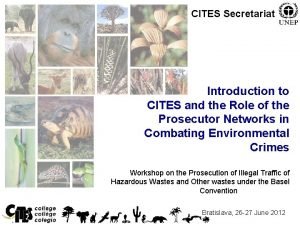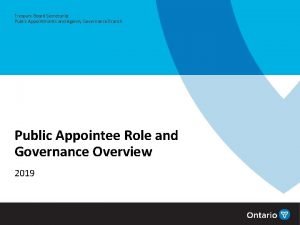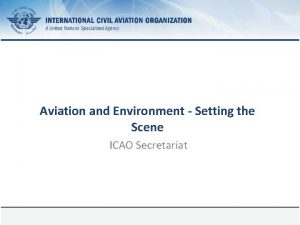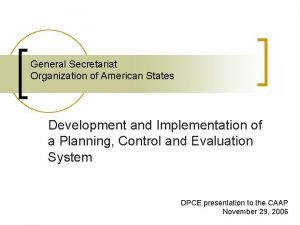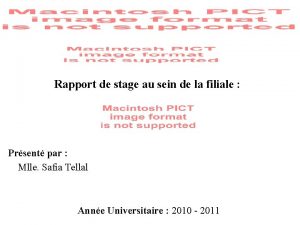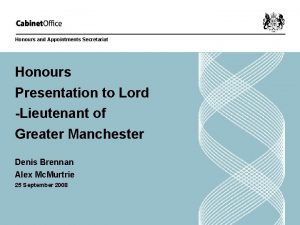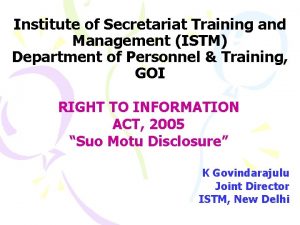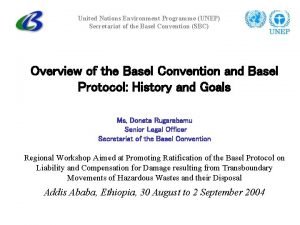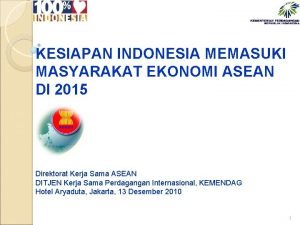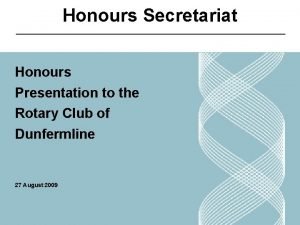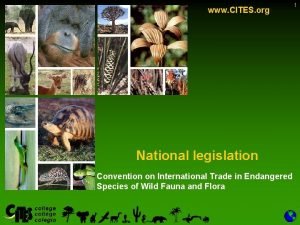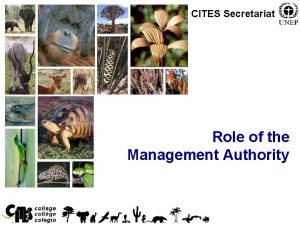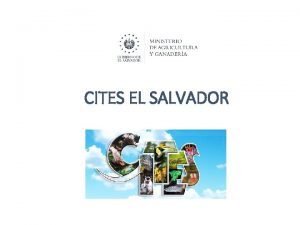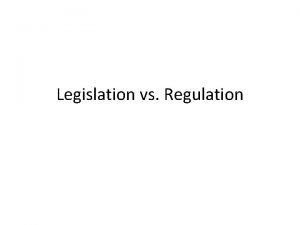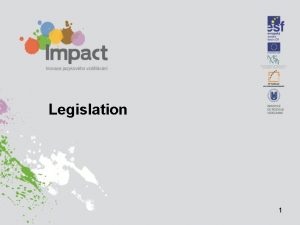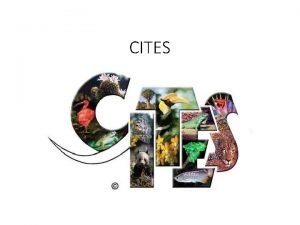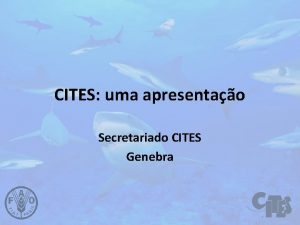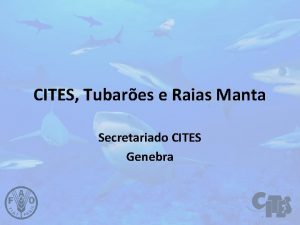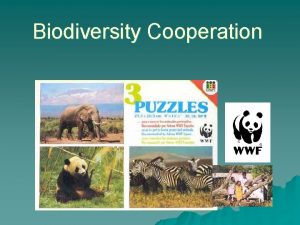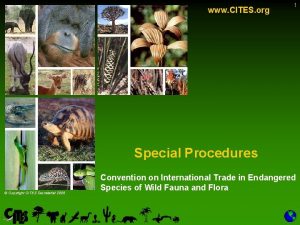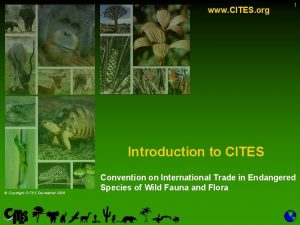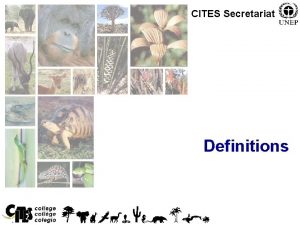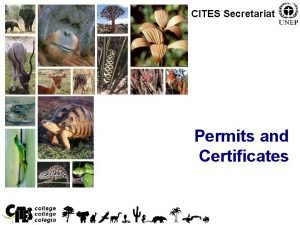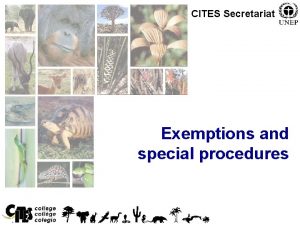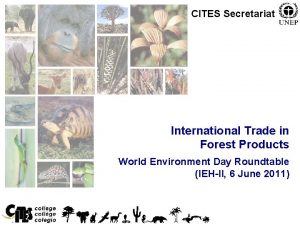1 Implementing CITES in National Legislation CITES Secretariat





















- Slides: 21

1 Implementing CITES in National Legislation CITES Secretariat

2 CITES COMPLIANCE National Legislation Project Review of Significant Trade National Reports CITES COMPLIANCE Captive breeding Response to illegal trade/NIAP Article XIII

3 NLP - Analysis (1) Under Resolution Conf. 8. 4 (Rev. Co. P 15), the Secretariat is directed to identify those Parties whose domestic measures do not provide them with the authority to 1. Designate at least one Management Authority and one Scientific Authority 2. Prohibit trade in specimens in violation of the Convention 3. Penalize such trade; or 4. Confiscate specimens illegally traded or possessed These are the four minimum requirements to national legislation for the implementation of CITES

4 NLP - Analysis (2) Based on analysis, legislation is placed in one of three categories: Category 1: legislation that is believed generally to meet the requirements for implementation of CITES Category 2: legislation that is believed generally not to meet all requirements for the implementation of CITES Category 3: legislation that is believed generally not to meet the requirements for implementation of CITES

Key Convention provisions • The Parties have some guidance on what is essential to include in their legislation – Article II of the Convention requires Parties to only allow trade in specimens of CITES-listed species in accordance with the provisions of the Convention – Articles III to VII set forth the conditions under which trade is allowed to take place – Article IX requires that Parties designate a Management Authority and a Scientific Authority – Article VIII requires that Parties prohibit trade in specimens in violation of the Convention, and penalize such trade and allow for confiscation of specimens illegally traded or possessed 5

Res. 8. 4 and related guidance • The practical application of each requirement involves considering and addressing several components. • These components help to clarify what is meant by each requirement and to provide criteria for determining whether a requirement is met by the legislation of the Party concerned. • The components are not equally considered under the NLP. They are considered as follows in this presentation: – Essential (e. g. required by the Convention itself); – Recommended (e. g. in a Resolution); or – Good practice (e. g. derived from Category 1 legislation or other sources) 6

I. Designation of authorities Essential Art. IX • The CITES Management Authorities and CITES Scientific Authorities should be designated by a legal instrument (law, regulation, decree) • The legislation should clearly and precisely describe the roles and responsibilities of the national CITES MA and SA and specifically give them the powers to carry out these responsibilities (power to grant – and not to grant - permits and certificates, power to establish export quotas, etc. ) 7

Designation of authorities (2) Recommended Res. 10. 3, Res. 11. 3, Res. Conf. 18. 6 • The Scientific Authorities should be independent of the Management Authority(ies) and the functions (roles and responsibilities) of the Management and Scientific Authorities should be separate. • If several MAs are designated, only one should be appointed for official communication with the CITES Secretariat and other Parties • Legislation should require and provide mechanisms for coordination, collaboration and communication between the Management and Scientific Authorities as well as with other relevant government agencies (e. g. Customs, police, border control, sector ministries/agencies responsible for fisheries, forestry, foreign trade etc. ) 8

II. Prohibition of trade violating CITES Essential Articles II, IV, V, VI and VII • All species included in the three Appendices of the Convention must be covered by national legislation irrespective of whether they are native or exotic. • Timely (automatic) amendment of any annexes or schedules to reflect periodic changes made to the Appendices. • All types of CITES specimens (live or dead animals and plants, as well as parts and derivatives) taking into account all annotations used in the Appendices • All types of trade transactions under the Convention (export, import, re-export, and introduction from the sea, irrespective of their commercial or non-commercial character) 9

Prohibition of trade violating CITES (2) Essential (Continued) • General clause prohibiting any trade in CITES specimens in violation of the Convention (e. g. without a valid permit or certificate), as a catch-all provision • Conditions and procedures for the granting of permits and certificates required for trading in CITES specimens should be clearly set out in the legislation to ensure that such trade is legal (legal acquisition finding), sustainable (NDF) and traceable (marking etc. ) • The care of live animals in trade should be addressed in the legislation • The legislation should consider exemptions and special procedures set out in the Convention Article VII, as appropriate 10

Prohibition of trade violating CITES (3) Recommended Res. 12. 3, Res. 10. 21, Res. 9. 6, Res. 9. 7 • The legislation should include a standardized form for the national CITES permit/certificate (e. g. in an annex) • The legislation should cover any specimen which appears from an accompanying document, the packaging or a mark or label, to be a part or derivative of an animal or plant species included in the Appendices, unless specifically exempted • The Live Animal Regulations and the Perishable Cargo Regulations of the International Air Transport Association (IATA) and the CITES Guidelines for the non-air transport of live wild animals should be taken into account (as a reference) • Legislation should provide for the inspection of specimens in transit, or being transshipped, to verify the presence of a valid CITES permit or certificate as required under the Convention or to obtain satisfactory proof of its existence 11

Prohibition of trade violating CITES (4) Good Practice • The legislation should be aligned as closely as possible with the provisions, language and spirit of the Convention • The legislation should replicate the distinction between Appendices I, II and III of the Convention 12

13 III. Penalization of illegal trade Essential (Conv. Art. VIII) • A clear definition of the prohibited actions/activities should be included in the legislation, for example: – trade without a valid permit/certificate – possession of specimens that were illegally acquired/introduced – Falsification of documents / mis-declaration of origin/volume of the specimens – Attempts at any of the above • The legislation should specify that such actions/activities constitute an offence which is punishable by with adequate penalties, including imprisonment, fine, confiscation, suspension of activity, etc.

14 Penalization of illegal trade (2) Recommended Resolution Conf. 11. 3 (Rev. Co. P 18) • The ministries and agencies and their agents mandated to enforce the Convention should be clearly designated in the legislation and should have the necessary powers and authorities to carry out their functions • Cross-references to any offences and penalties related to CITES that are provided in Customs, general crime/penal, environmental or other legislation • A maximum penalty of at least 4 years of imprisonment for CITES-related offences involving organized crime or trafficking in endangered species

15 Penalization of illegal trade (3) Good Practice • The criminal legislation on regulated or prohibited goods, organized crime, money laundering, controlled deliveries, wire tapping, the use of informants, etc. should cover serious offences related to CITES • The legislation should provide offences and penalties for attempted violations, aiding and abetting, corporate and corporate officer liability, recidivism, obstruction of justice, false statement, tampering, fraud

16 IV. Authorization to confiscate Essential Conv. Article VIII, paragraph 1(b), paragraph 2 • The legislation (either specialized CITES legislation or other legislation) shall provide for the permanent confiscation - as distinguished from the temporary seizure - of illegally traded or possessed specimens

17 Authorization to confiscate (2) Recommended Conv. Article VIII, Res. Conf. 17. 8 • The legislation should specify which authorities have the power to confiscate, the extent of their confiscation powers, the procedures that must be followed, including for decision on temporary and final disposal of confiscated specimens; • The legislation should allow for costs of storage, destruction, return to the country of origin etc. of confiscated specimens to be charged to the offender; • The MA should have the authority to designate rescue centres to look after confiscated living specimens

18 Authorization to confiscate (3) Good Practice • The legislation should authorize the confiscation of not only specimens but also vehicles, vessels, containers, equipment, etc. used in the commission of a CITES-related offence • Confiscation of specimens of CITES-listed species involved in an infraction should be compulsory. • The application of this precautionary measure should not be subordinated to the identification of the offender and the penal liability of the accused

19 Developing national legislation • Parties’ experience in the development of strengthened CITES implementing legislation has shown the importance of – simultaneous preparation of enabling and implementing legislation – provision for the timely incorporation of periodic amendments to the CITES Appendices – addressing illegal possession as well as illegal trade – ensuring policy coherence in relation to national wildlife trade policy, other biodiversity-related conventions to which a State is party, natural resource management (including fisheries management), the criminal justice system and development policy

Legislative plan • Approach (Act or secondary) • Timeline and related outputs • Responsible lead ministry or agency • Other ministries, agencies, stakeholders to be consulted • Consultation with the CITES Secretariat 20

Support • www. cites. org • NLP web page: https: //cites. org/legislation • Model law and check list • CITES virtual college: www. cites. unia. es • Sofie. flensborg@un. org 21
 Cites secretariat
Cites secretariat National policy and legislation related to child health
National policy and legislation related to child health Nfpa 1600 standard
Nfpa 1600 standard Nfpa 1600 business continuity programs
Nfpa 1600 business continuity programs Public appointments secretariat
Public appointments secretariat Trans kalahari corridor secretariat
Trans kalahari corridor secretariat Secretariat scene
Secretariat scene Secretariat family tree
Secretariat family tree General secretariat for development planning
General secretariat for development planning Rapport de stage exemple
Rapport de stage exemple Literacy and numeracy secretariat
Literacy and numeracy secretariat Agri benchmark
Agri benchmark Pacific island forum secretariat
Pacific island forum secretariat Honours and appointments secretariat
Honours and appointments secretariat Institute of secretariat training and management
Institute of secretariat training and management Unep secretariat
Unep secretariat Asean secretariat
Asean secretariat Digital secretariat cg
Digital secretariat cg Honours secretariat
Honours secretariat Cites.org
Cites.org Cites management authority
Cites management authority Which statement cites an example of cultural diffusion?
Which statement cites an example of cultural diffusion?
